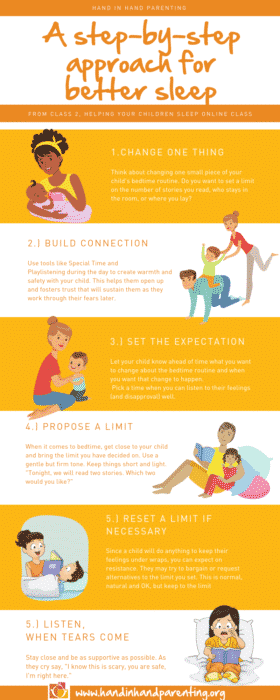What does your child need to go to sleep?
For some, it's a pacifier and a story.
For others, it's a special toy, a hug and their favorite music.
For others, it's two stories, a snuggle, a song, a glass of milk, and to be held in a special way.
Every child has a different way to fall asleep.
But if your child has trouble falling asleep – they complain and whine if you don't do it the same things in the exact same way every single night – or they wake in the night many times, these special routines are telling you something.
A Word About Sleep Disruption and Fear
Every child has fears. There's nothing unusual in that. Children can pick up anxieties and get scared about many different things, and rarely do we know about them. Overhearing an adult talk sternly or shout can be scary, even if heard indirectly. Cartoons can be scary. A dog suddenly barking can be scary. Sliding the big slide can be scary. An older sibling can be scary. Children tuck each of these fearful experiences away, deep in their minds. It's important to know that it's impossible for us as parents to shield and protect our children in a way that they don't pick up fear.
But what does this have to do with helping a child sleep, you might ask.
When a child can't sleep it's because those fears show up at night. The unconscious mind serves up all those fears that children bury, and because the conscious mind is not on duty, it can't manage them. Instead, the fears breakthrough and interrupt sleep. Again and again.
What Do A Child's Bedtime Routines Tell Us?
When a child gets rigid about their bedtime routines, it's a sign that there are fears under the surface. Children attach to a particular routine as a way to bury those fears deeper. Fear is not fun to experience, obviously, and their mind latches on to these routines as a calming device. A way to avoid feeling those feelings.
Yet, this doesn't work. Instead fears come through while a child sleeps, as dreams and nightmares, and wake the child. Soon, the expectation that dreams will come becomes scary in itself. Bedtime, along with the separation that is a natural part of sleep, becomes harder and scarier.
Getting those feelings out and heard in a supportive way is a good way for kids to process and move past them. You can learn more about how listening to a child's feelings is helpful in boosting confidence, resilience, and well-being in this post. And the best way to do that is to slowly, in very small steps, begin by changing the routine, because when you change the routine slightly, those feelings will come up.
The One Question You Need To Ask To Help a Child Sleep
So, before you look at how to help a child sleep better ask yourself if routines could be holding your child back from a good sleep. Note down what things your child demands of you in order to fall asleep.
- Do they need you to lie with them just so?
- Do they insist on one more story?
- Do they constantly interrupt while you are reading and then ask you not to turn out the light?
Try This Step-By-Step Guide to Helping Children Sleep Better
In the Hand in Hand Parenting online class, Helping Your Children with Bedtime and Sleep, Founder Patty Wipfler outlines a supportive, step-by-step process to help your child sleep, starting with changing the routine.
 Begin by Changing Just One Thing
Begin by Changing Just One Thing
What is it you want to change? Do you want to set a limit on the number of stories you read, who stays in the room, or where you lay? Begin by deciding to change just one small part of the routine.
Build Connection
Use tools like Special Time and Playlistening during the day to create warmth and safety with your child. This helps them open up and fosters trust that will sustain them as they work through their fears later.
Set The Expectation
Let your child know ahead of time what you want to change about the bedtime routine and when you want that change to happen. You may find they cry then at the very thought of this change. So pick a time when you can listen to all the feelings they have about change and their reasons for not wanting it. Tears show that they are working on fear, and hearing all they have to say builds the trust they need to be able to show you those fears. This is the very beginning of change happening.
Propose a Limit
When it comes to bedtime, get close to your child and bring the limit you have decided on. Use a gentle but firm tone. Keep things short and light. “Tonight, we will read two stories. Which two would you like?”
Reset a Limit if Necessary
Since a child will do anything to keep their feelings under wraps, you can expect on resistance. They may try to bargain or request alternatives to the limit you set. This is normal, natural and OK, but keep to the limit. “I hear that you'd like one more story, but from now on, we are reading two each night.”
Soon after, you will see tears. This is your child's natural way to work through their fears. These big passionate feelings help them heal from all those underlying fears that clog their thinking in the day and keep them awake and anxious at night.
Changing the routine helps them access their feelings ahead of falling asleep so that the fears don't show up so much as dreams, nightmares or nervousness. Instead, children are calmer, go to sleep easier and stay asleep uninterrupted.
You'll need to stay close and make the environment as supportive as possible. As they cry you can say, “I know this is scary, you are safe, I'm right here.”
How Does Changing The Routine Help Children Sleep Better and Longer?
You may find that one big cry on day one does much to help alleviate a child's fears and they begin sleeping better quickly. Other times, you'll have to spend a few nights re-stating the limit and listening to the feelings that follow.
If there are a series of routines in place, you will work, step-by-step to change more of them, one at a time. You will see big changes using this way to help kids find the confidence they need to sleep through the night.
You can find a full explanation of this step-by-step approach to helping children sleep better in this video, taken from the class How To Help Kids Sleep Better.
Learn this revolutionary approach to helping kids sleep better. With video instruction, literature, and infographics this three-week extensive class on sleep will help you:
- Figure out why your child won't take naps
- How laughter and play is linked to better sleep
- Nursing and Sleeping: Setting Limits and Expectations
- Use solutions for nightmares, night-waking and bed-wetting
- Understand children's emotions and behaviors
To download a PDF of the approach click here: A Step-by-Step Approach to Help Children Sleep PDF
Find out what stops kids from sleeping, how to set limits around sleep and how to build your child's sleep confidence. Get Hand in Hand Parenting's Helping Your Children with Bedtime and Sleep online class now.


